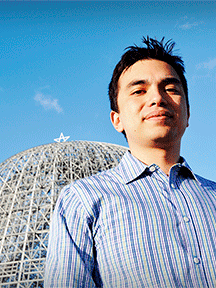By Julia Bianco
Mike Chen is the co-founder and Strategic Officer of Made in Space, a company founded in 2010 with the goal of bringing 3D printing to space to “push the boundaries of space exploration.” The first of its kind, Chen’s microgravity-tested 3D printer launched to the International Space Station on September 21, 2014.
Chen, who founded his first company in 2002, graduated from Oberlin College in 2009 with high honors and membership in Phi Beta Kappa.
Made in Space is a combination venture between 3D printing experts, entrepreneurs, engineers, and space experts, including three-time astronaut Dan Barry. Chen told In Habitat that working with Barry was particularly helpful in convincing the team how important 3D printing could be in space.
“Through talking with [Barry] and understanding the unique challenges of space exploration and thinking about 3D printing a lot, all of us together came to the realization of how game changing it was going to be,” said Chen.
Made in Space hopes that bringing a 3D printer to space will pave the way for future colonization of space, an idea that is frequently discussed but, for a number of reasons, has never had the true possibility of becoming reality.
According to Chen, one of the primary reasons that space colonization seems so impossible is the sheer cost. Launching anything into space costs about $10,000 per pound, plus the costs of designing a product that could function in a zero gravity environment. Anything launched into space has to have a functionality and longevity that requires years of expensive research.
After discussing the realities of space travel with Barry, Chen and the other entrepreneurs at Made in Space realized that, by 3D printing objects at a location that was already in space, they could save money and time by not having to build objects that stand up to the tough requirements of a space launch.
“Structures that are 3D printed in orbit can be much more elegant, in some cases not even strong enough to support their own weight on earth, yet fully functional in microgravity,” said Barry. “3D printing tools, parts and structures on-demand in space enables us to build parts with minimum materials and have them immediately available for use. The reduction in spare parts requirements alone represents a huge savings in costs and logistics complexity.”
Made in Space’s 3D printer, the result of years of research and testing, is the first 3D printer ever launched into space, but it won’t be the last. In 2015, Made in Space hopes to launch a second, more advanced 3D printer to the ISS. Eventually, he hopes to create a printer that can produce objects using multiple materials, including metals, rather than just polymer.
Chen sees a big future for 3D printing in space. He believes that 3D printing can lead to biological testing in space, longer missions that aren’t limited by a lack of resources, and, eventually, the ability to extract resources from asteroids, planets, and moons that can be used to sustain human life in space.
With the September 21 launch comes a whole new set of opportunities for space travel, and Chen is eager to see what the 3D printer can bring to the future of space exploration. Made in Space is making their printer available to the public—anyone who wants to design something that they think should be printed in space can create the design on Earth and email it to info@madeinspace.us. By crowdsourcing these ideas, Chen hopes that we will be able to “realize the space colonization dreams of the last century.”
Julia Bianco is a junior at Case Western Reserve University. She is a double major in cognitive science and political science, with a minor in English. Case Western is home to the Alpha of Ohio Chapter of Phi Beta Kappa.




